2 December, 2003
Condition ONE!
Well… we definitely are not leaving McMurdo Station for Fang Camp today!
We threw open the heavy blinds on our dorm windows, which block out the
midnight sun, and found a wall of white. The weather monitor in the
lobby was flashing “Condition ONE.” We were trapped!
Out of curiosity, I looked up the definitions of each of the three
Antarctic weather conditions, as outlined by the U.S. Antarctic Program.
Condition ONE is called when any of the following conditions are met:
visibility of less than 100 feet, winds greater than 55 knots, or wind
chill below than –100 degrees Fahrenheit. Condition TWO is defined as
visibility of less than 1/4 mile but greater than 100 feet, wind speeds
of 48-55 knots, or wind chill below –75F but higher than –100F.
Condition THREE is simply defined as “anything better than condition TWO.”
After almost two weeks at Condition THREE in McMurdo, I had started to
believe the weather here wasn’t much worse than a typical winter day in
Northeastern Pennsylvania. The big, fluffy snow that had fallen in the
last two days had lulled us into a quaint view of an Antarctic storm.
This, however, was the real-deal.
Under Condition THREE, unrestricted travel is allowed on base and out
onto the ice. At Condition TWO, travel between buildings on base is
permitted, but only authorized trips are allowed out of McMurdo and
nearby field parties are often escorted back to base by SAR (Search and
Rescue). At Condition ONE, no one is allowed to leave the buildings. So
if you are in the dorm, you stay there with a bed, bathroom, and dining
hall. If you are caught in the lab, life is still pretty comfortable,
with bathrooms and hot drinks. However, if you are in the Food Room or
out at a fish hut, you must stay put regardless of how hungry, tired, or
bored you get. I’ve decided that it pays to keep a book and a deck of
cards in your pocket here!
Enjoy the photos of our day at Condition ONE.

1. Figure 1 – One clue that we weren’t leaving McMurdo today was that the helicopter rotors were tied down to the pad to prevent damage.
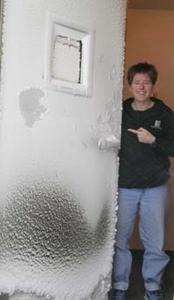
2. Figure 2 – Gusting winds caused large drifts to build up and left doors frosty. We were thankful for the heavy metal doors on the science lab that shut out the cold drafts and snow.

3. Figure 3a – Condition THREE. This photo was taken looking from the front door of the Crary Science Lab toward Building 155 (my dorm and the dining hall). Notice that two bright red vehicles are visible in the photo.
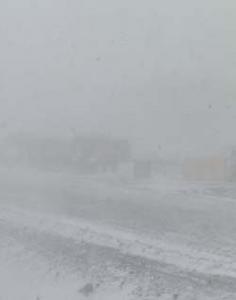
4. Figure 3b – Condition ONE. This photo shows the same field of view as Figure 3a (notice the large rock along the road in the foreground for reference), but was taken during the storm. If you look hard, you can see the faint form of the two red vehicles parked in the same spots they were in Figure 3a. Having walked this route moments before taking the photo, I was covered in wet snow and my face felt frozen. Even though the conditions hadn’t changed at all, the weather station will temporarily downgrade the official Condition rating to allow people to run to the dining hall for lunch.
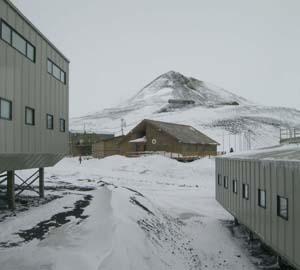
5. Figure 4a – This is the typical view from the hall connecting Crary Levels 1 and 2 (seen as tan buildings on the right and left of the photo) at Condition ONE. Notice that the National Science Foundation (NSF) Chalet is easily visible about 300 yards away. Observation Hill towers 750 feet high in the background.
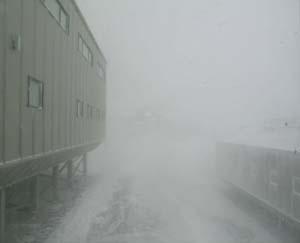
6. Figure 4b – This photo shows the same field of view as Figure 4a. The weather was still only condition TWO when this photo was taken! Not only has observation hill completely disappeared, even the NSF Chalet is obscured.
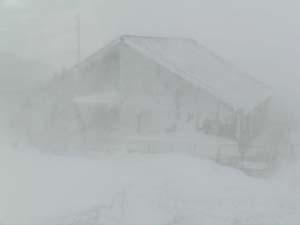
7. Figure 5a – As we stood warm and snug in the third level library at Crary Science Lab, the NSF Chalet nearly disappeared from view.

8. Figure 5b – Taken two hours after Figure 5a, this photo shows how quickly the weather can change. The Condition ONE storm downgraded directly to Condition THREE and while the clouds didn’t clear, the wind and snow died down.
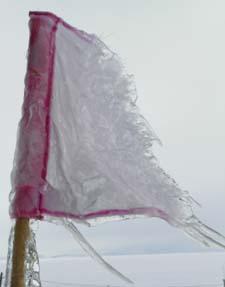
9. Figure 6a – A faded old marker flag is crystallized in a sheet of ice after the storm.

10. Figure 6b – Large icicles dangle from the bamboo pole, reaching out like many chilly fingers.
Contact the TEA in the field at
.
If you cannot connect through your browser, copy the
TEA's e-mail address in the "To:" line of
your favorite e-mail package.
|
